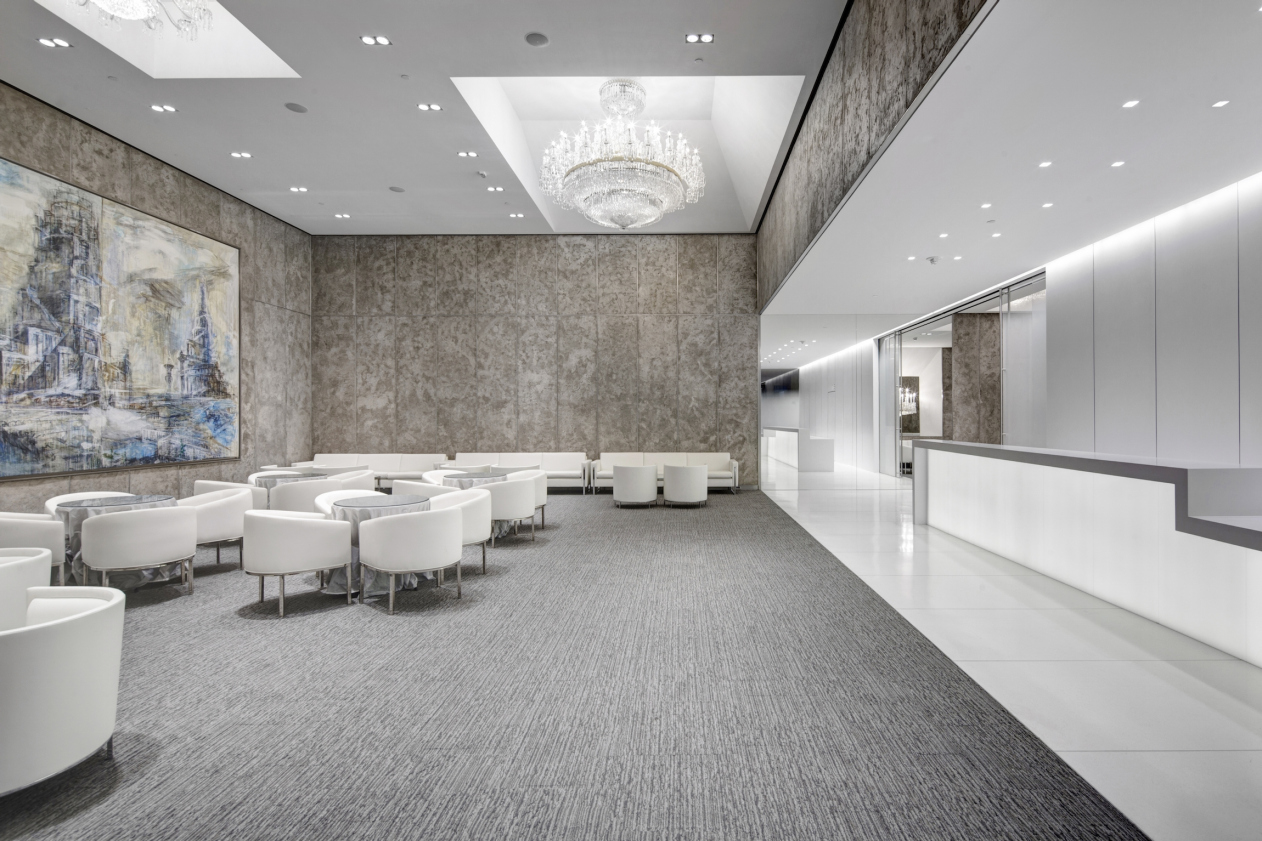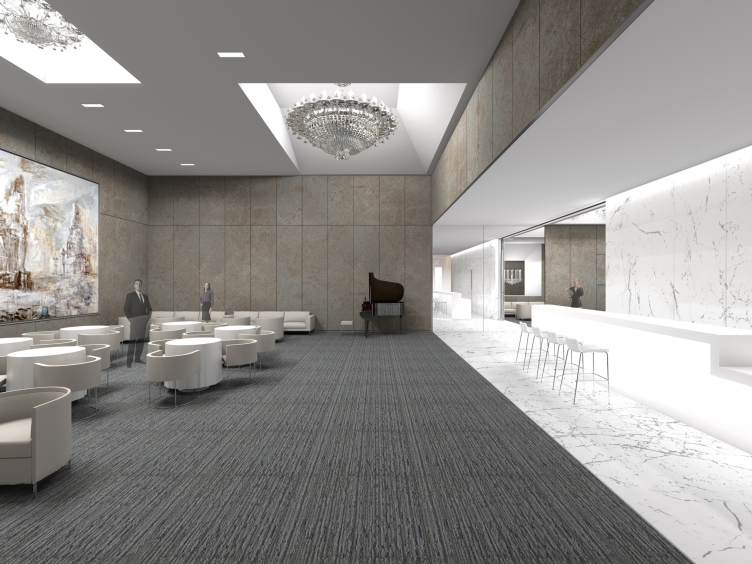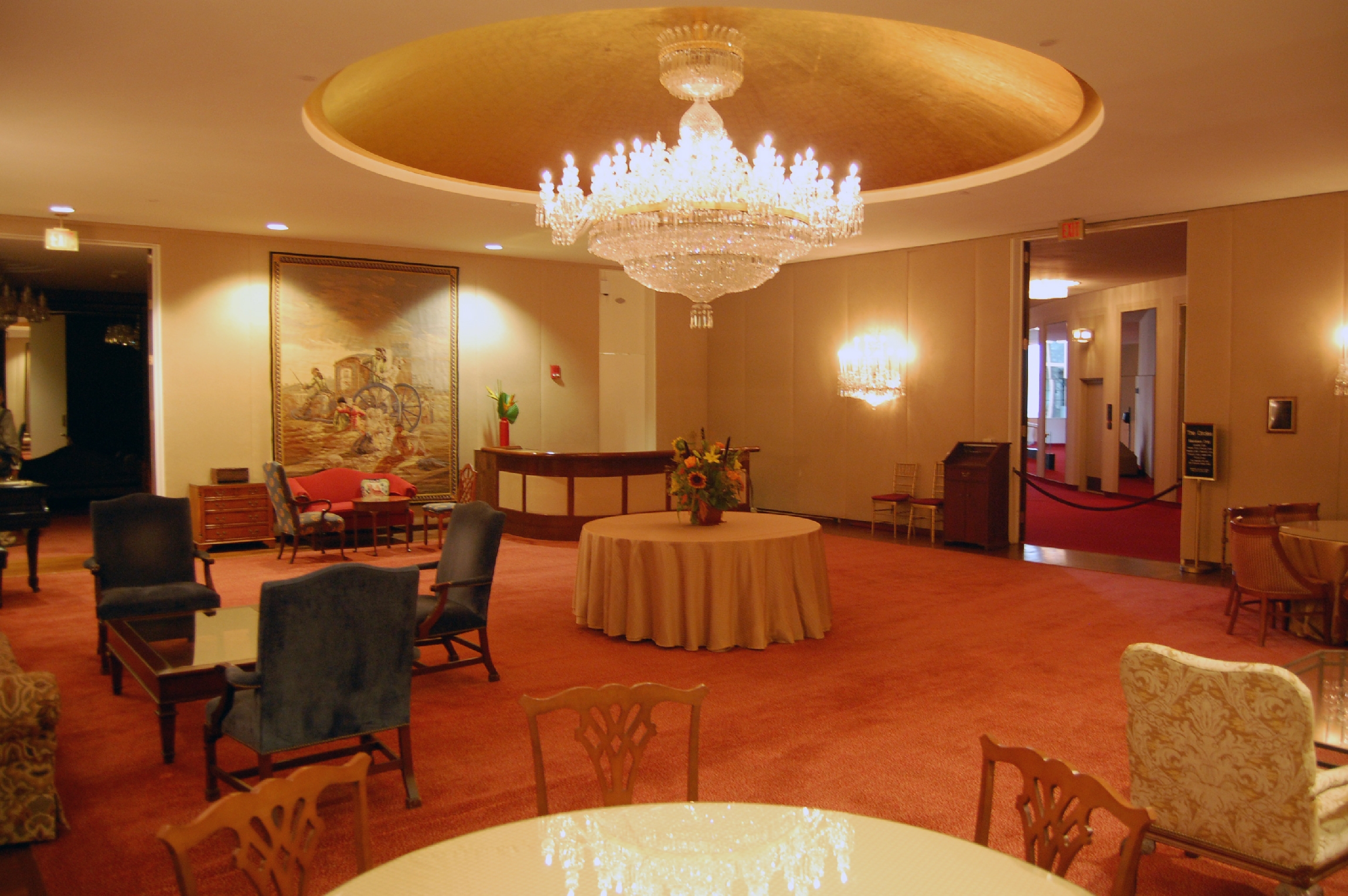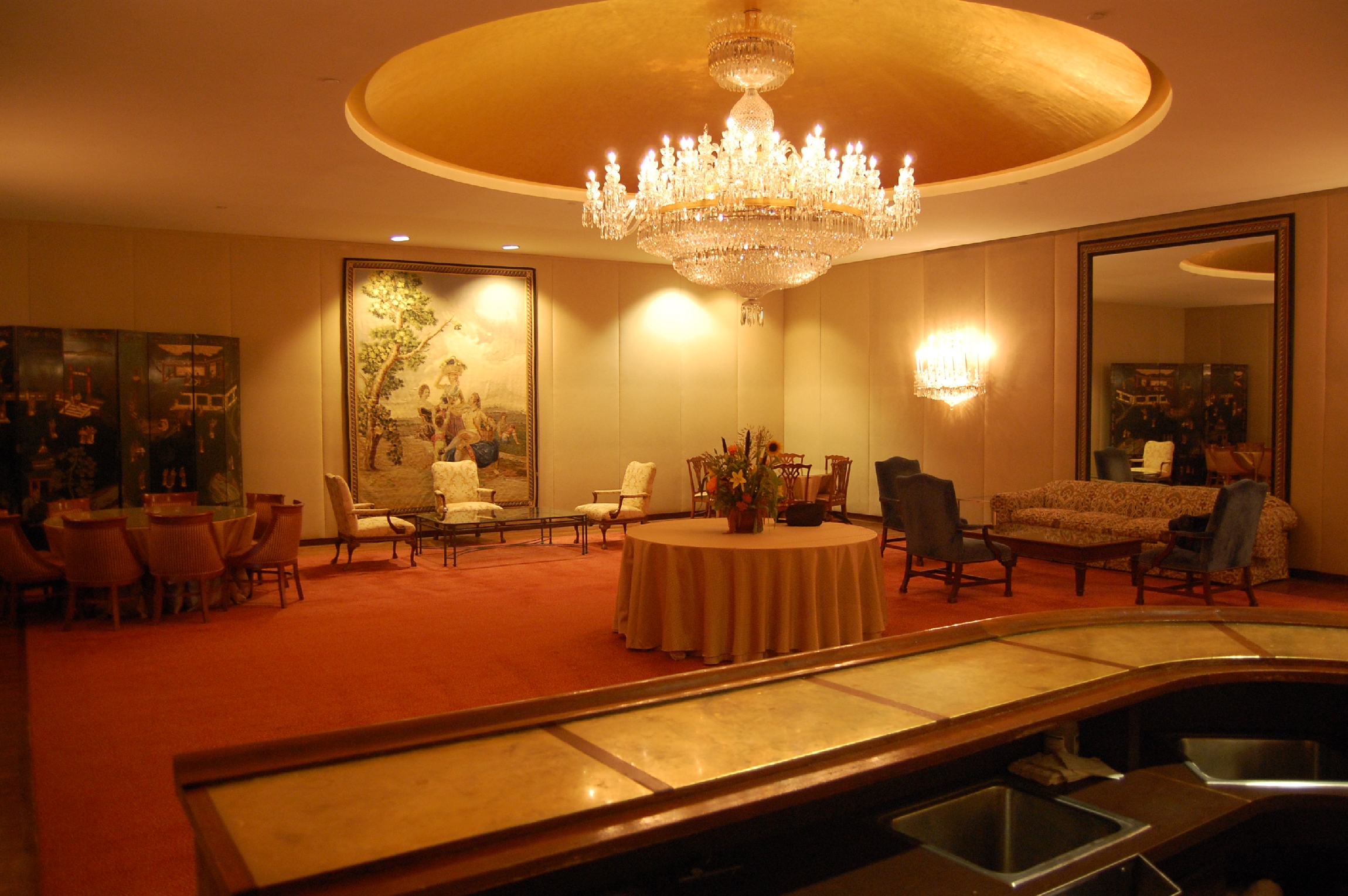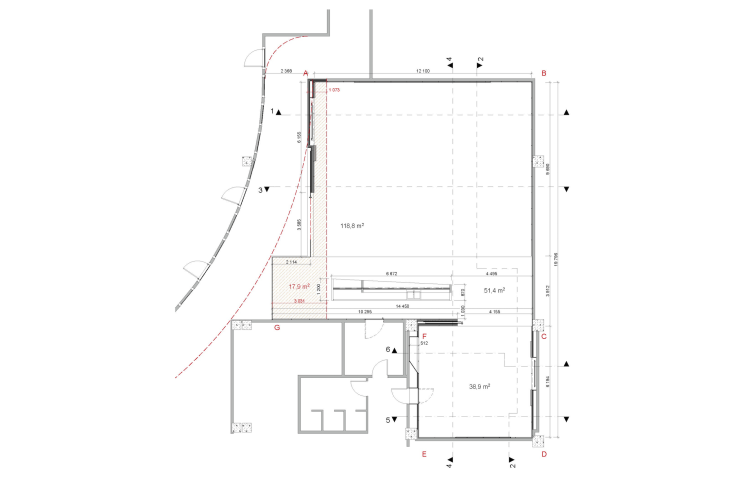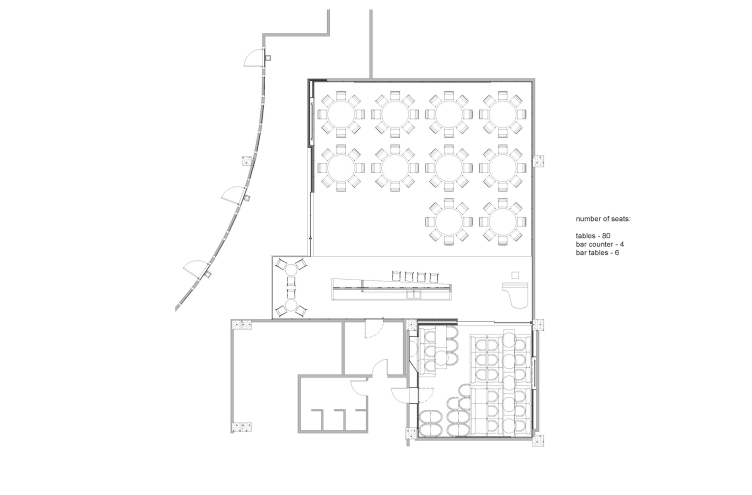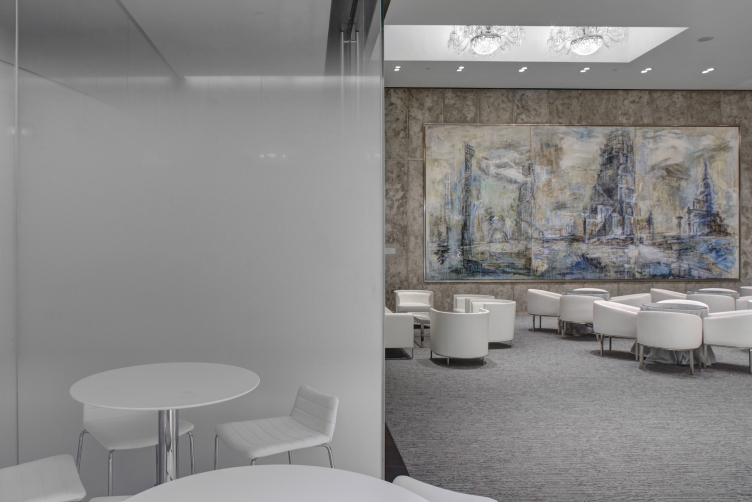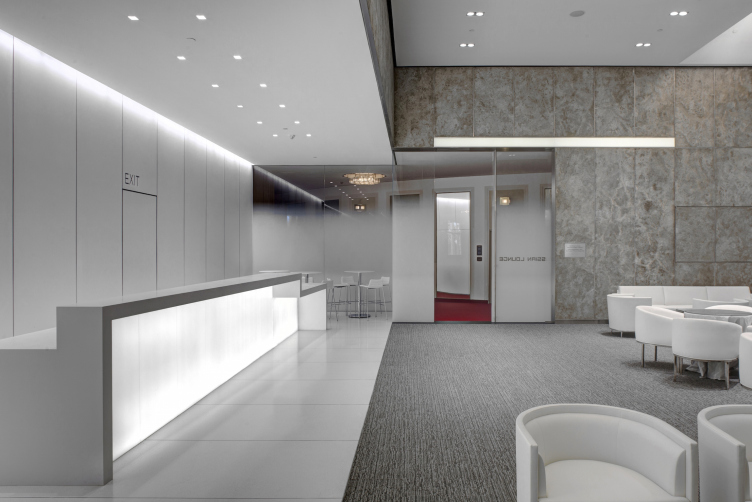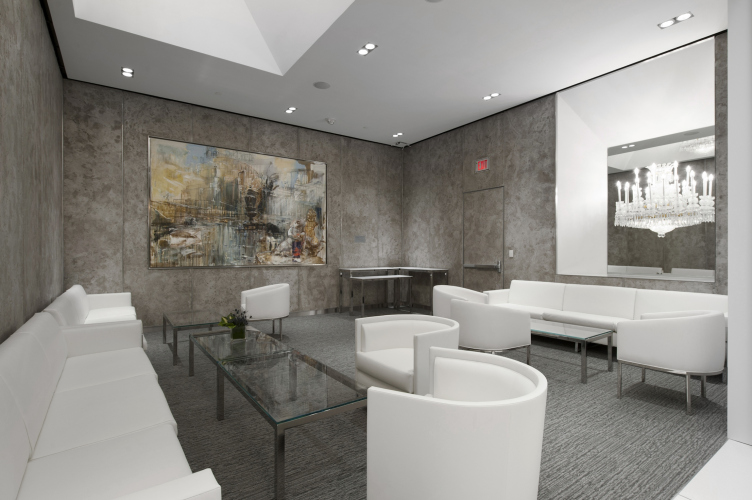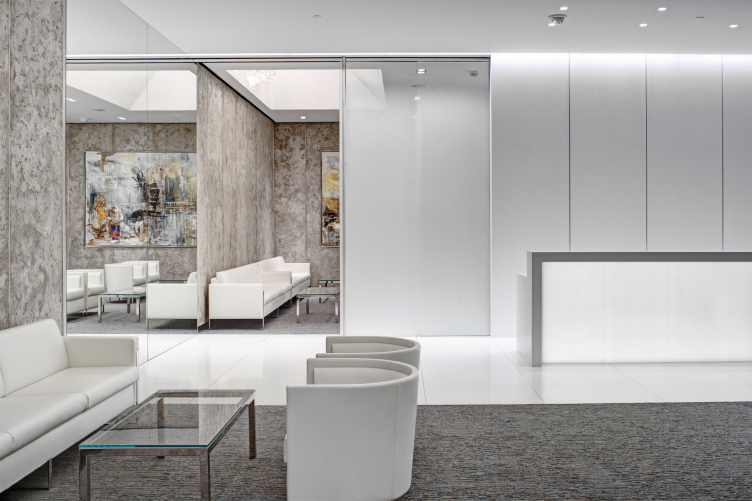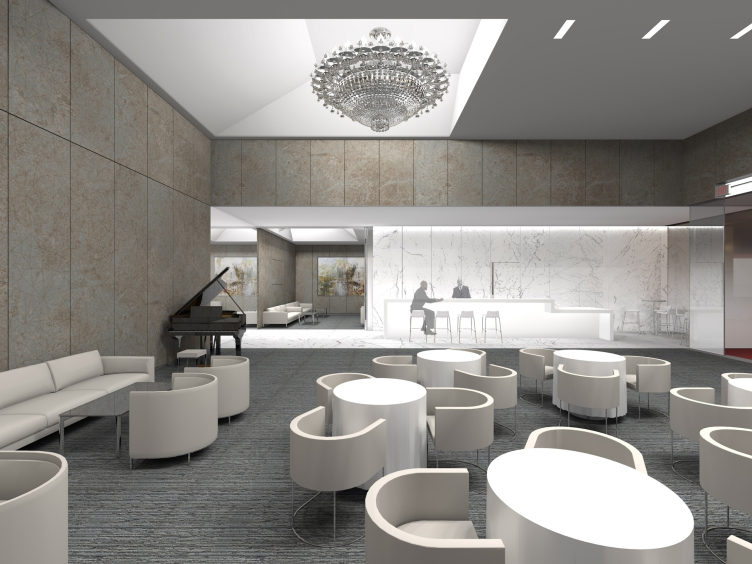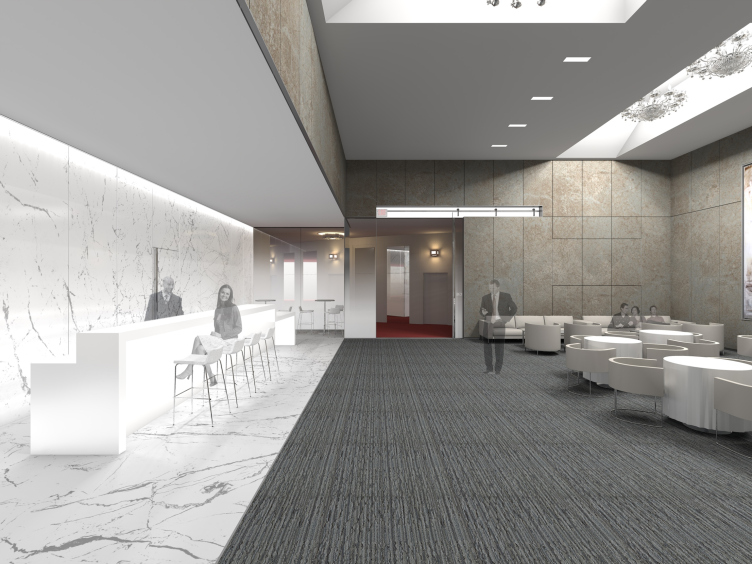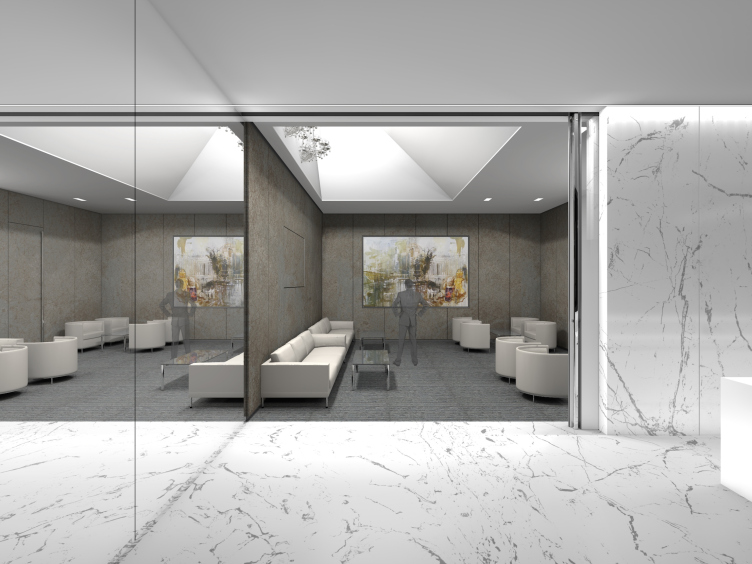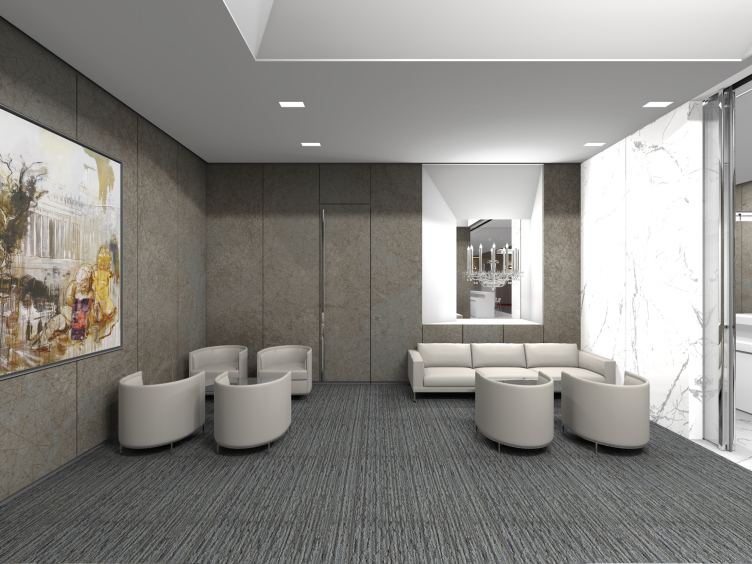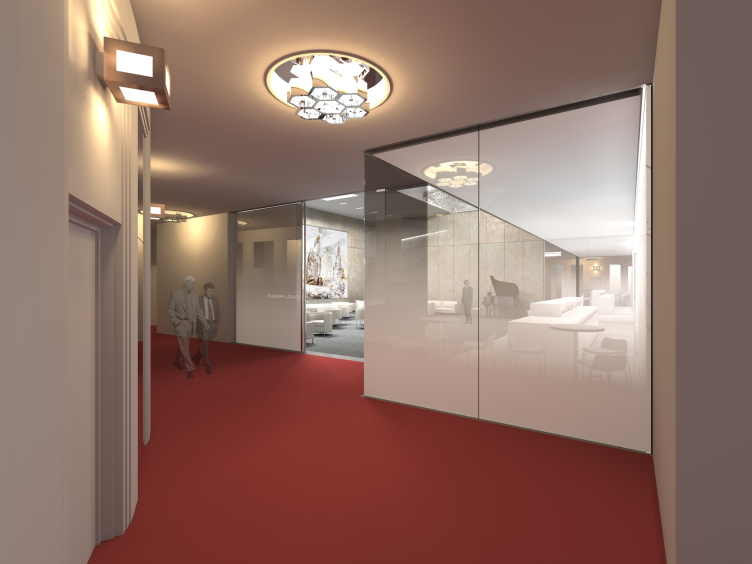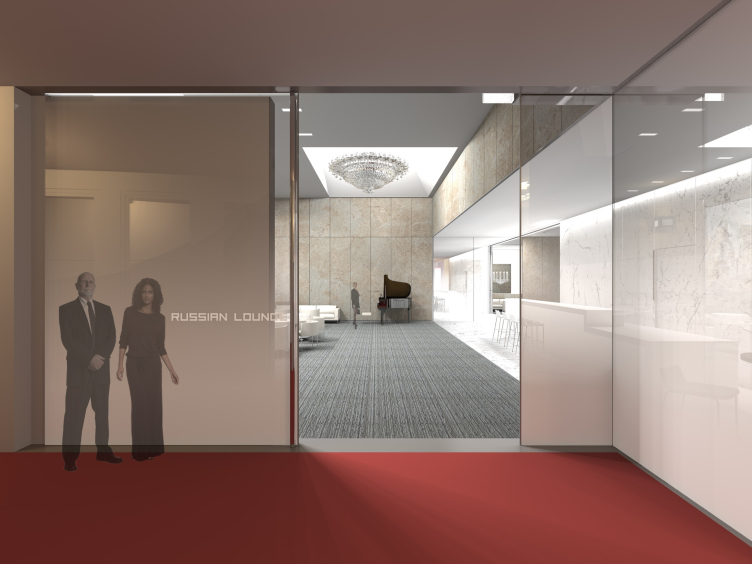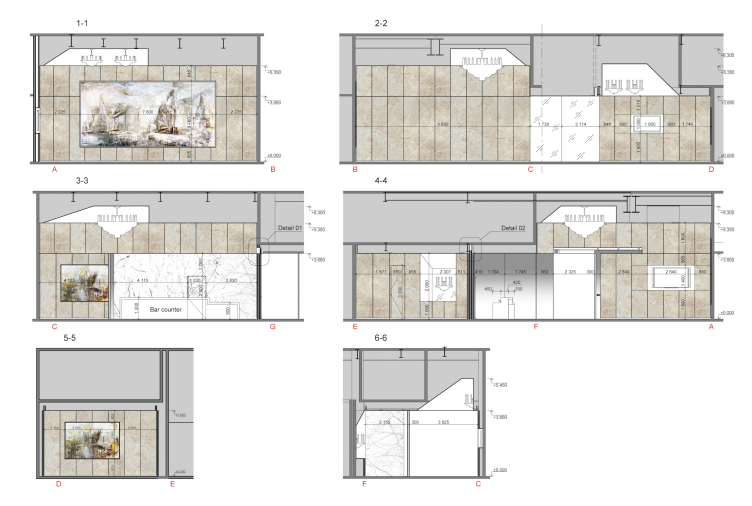The interior of the Russian Lounge in the Kennedy Center or the "Kennedy Center of the Performing Arts" in Washington was completed and inaugurated in 2014. Meant to promote international friendly ties, the radical transformation of two rooms of the center into a space that symbolizes Russia's presence in this ostentatiously multicultural institution became possible thanks to the charity donation from Vladimir Potanin that he made for the 40th anniversary of the Kennedy Center in 2011. The curator of the project is Natalia Zolotova who ten years ago organized for the Potanin Foundation a large anniversary project in Paris dedicated to the 300th birthday of Saint Petersburg. As part of the project, in L'hôtel national des Invalides, Natalia organized a successful exhibition named "Moscow - Saint Petersburg. 1800-1830. When Russia spoke French". Back then, in Paris, Natalia was able to procure for her exhibition an unusually-looking grand space of the historical building, and now she also proposed an ambitious idea for the Russian Lounge: completely transforming the old space of the lounge, trying not only to redecorate its traditional interior but also create a single modern artistic image - offering this task to a number of Russian established artists and architects. The idea got support from the organizers on both sides - the management of the Kennedy Center and the Potanin Foundation. The curator's condition of foregoing the plans of interior decoration and breaking away from the traditional "tourist" or "mono-ethnic" symbol set ("because Russia, as we all know, is a multinational country" - comments Natalia her decision) - got an approval from the customers. Furthermore, as Vladimir Potanin expounded in 2011, the visitors of the lounge were to get a "new impression of Russia as a beautiful, stylish, and modern nation".
In order to achieve this purpose, Natalia Zolotova proposed to her customers and organized a small closed tender to which she was able to attract great participants. Alexander Brodsky, Vladimir Dubosarsky, AES+F Group, Vlad Savinkin and Vladimir Kuzmin, Ivan Lubennikov, George Frangulyan, Ilia Utkin, Valery Koshlyakov, George Ostretsov, Sergey Skuratov - they all submitted brilliant projects, expectedly different. The curator explained her choice of contestants not only by their well-deserved professional reputation but also by the fact that all of the architects that she invited have long since been working with the topic of the current search for Russian identity.
The work of the bilateral Russian/American judging panel resulted in a victory of the project by Sergey Skuratov and Valery Koshlyakov, in which the former proposed a rather radical transformation of the interior, and the latter painted two really daring and mesmerizing pictures that literally grew into the lounge.
"Until the beginning of this work, I was not personally acquainted with Valery, even though I already knew him to be a great artist. But we made a great team together - Sergey Skuratov shares - Originally, I proposed two options, one being exclusively mine, and the other being based on Valery's paintings, in the same tone that he works in. This latter option was liked by both sides, and was later implemented almost exactly the way we'd planned it".
It must be said at this point that the American Kennedy Center is in fact a cultural and political symbol of national cohesion and peoples' friendship popular in the USA. "School tours are quite a common sight here" - Sergey Skuratov shares. The center was founded by President Eisenhower in 1958; after the assassination of Kennedy in 1963, the Senate appropriated the money to speed up its construction, and the building opened within a year, in the December of 1964, to become a "living monument" to President Kennedy. It is situated in the memorial part of Washington, D.C., on the bank of the Potomac River, across from the Roosevelt Island and next to the Lincoln Monument. The White House is a twenty minutes' walk away from here. Against the background of the antique porticos, meant to symbolize the founders of the nation's beliefs in the antique democracy values, the Kennedy Center stands out with its lightness and modesty: a low-rise building surrounded by broad terraces with awnings on evenly spaced slim pillars, prostrate on the ground, almost invisible behind the trees. In its center, there are three spectator halls separated by two double-height galleries: the States Gallery and the Nations Gallery, looking pretty much like identical twins. The interior of the center can, possibly, remind a post-soviet individual about the Brezhnev architecture - it looks a bit like the Lenin Museum in Gorky: the marble walls, the bronze hardware, the red carpets, tall stained glass windows, and the chains of crystal chandeliers.
The view of the entrance lobby of the Kennedy Center (interactive Google panorama):
According to the approach to such organizations, common in the USA, as well as the papers signed by Eisenhower himself, the Kennedy Center exists on the annual donations from private donors that get in return, besides getting their names mentioned in the lists of honor, the opportunity to get photos of them with the movie and music stars, priority booking status for concert halls, hotels, and travel tickets - in other words, what is generally called "VIP service" in Russia. There are four lounges, their interiors having already been designed by 2011 as: the Israel lounge with a bright lamp in the spirit of Klimt; the African one with slanted walls and crocheted mats; and the dark luxurious Chinese where the wooden wall panels are decorated with ornamental hieroglyphic pictures. That left the largest one, consisting in fact of two premises with a total area of 330 square meters - the Golden Circle Lounge whose name comes from the so-called "circle" of the corporate donors and benefactors: the smallest possible donation is an annual $5000, and is called Corporate Golden Circle. In other words, the "golden" circle of the sponsors gathers in this lounge. It is also visited by the American President and other high-ranking officials.
"This was a serious challenge - Natalia Zolotova comments - creating a new space that would form the atmosphere of the Russian cultural presence, in two small ceilings and with no windows... This looked like anything but an easy task from the very beginning. And this was not just any place – it was the Kennedy Center, where for forty years already, on seven stages, in hundreds of annual performances, new decorations have been used, daily transforming the space and creating new magic worlds. So you will have a hard time trying to surprise a spectator so spoiled by new impressions".
Before the reconstruction, the Golden Circle Lounge was covered by red carpet and furnished with differently styled pieces, its main attraction being a crystal chandelier - a gift from Ireland, which was placed in a golden recession on the ceiling, a "golden dome" of sorts, which symbolically reflected the name of the lounge.
Renovating "Golden Circle Lounge" into "Russian Lounge" in the Kennedy Center of the Performing Arts. Visualization © Sergey Skuratov ARCHITECTS
Golden Circle Lounge before it was turned into Russian Lounge. Photo courtesy of Sergey Skuratov
It was requested by the center that the Irish Chandelier, along with its little sisters hanging on the walls, be kept intact; all the rest was allowed to be subject to change. And Sergey Skuratov would not have been himself if he had limited himself with the inexpressive volume that was only allotted to him. Seeing from the section view that, behind the low ceiling, there is quite a fair amount of space - almost half of the entire height of the room - he requested from the center detailed drawings, got the old blueprints via email, and, having thoroughly studied all the possibilities, proposed an unexpected and radical solution, at some places raising the ceiling as much as three meters up and changing the air duct system.
The architect proposed equipping the lounge with real windows that would cut the south wall which joins the Nations Gallery - this would yield what sunlight it could - and the room would then command an impressive top view of the flags in the double-height gallery. However, the management of the center did could not go for it. But then again, Sergey Skuratov, not in the least discouraged, found a way to expand, or rather, slit through the space of the lounge not physically but by way of using perspective and lighting techniques that can be actually traced back to the baroque architecture; nevertheless, they look quite up-to-date, balancing on the verge of cultural traditions.
"The space that got opened up so unexpectedly was quite a sight to look at, and all the employees of the center, from the management to the maintenance workers, would come to take a peek at this wonder - Natalia Zolotova shares - this indeed looked like some kind of miracle, and it reminded me of Hamlet's words "I could be bounded in a nutshell and count myself a king of infinite space". Hundreds of years ago, Shakespeare so aptly expressed just what Skuratov did today that we, together with our American colleagues, decided to put this quote on the pamphlet that is published by the Kennedy Center specially for the occasion of the inauguration of the Russian Lounge".
As for the raised ceiling, the author supplied it with deep "wells" of sun tubes with wide perspective slants, placing into these sun tubes the chandeliers (taken apart and put back together again) with their frameworks having but a slight fraction of golden elements and now dominated by silver. Being completely tucked away from the space of the lounge, the chandeliers leave plenty of room in it, while the recessions, when viewed from the brightly lighted slants, look like neon lamps. This is the first illusion because the light is white but artificial; what it seems like, however, is that the crystal structures are suspended directly from the sky.
Further on: Sergey Skuratov separated the two parts of the lounge - a larger and a smaller hall, situated on the right behind it - with a white "blade" of an elongated bar counter. The counter is made of Corian; the wall behind it and the floor underneath it are coated with white marble with gray streaks, all this being lit with opaque but still bright light. Near the north side wall of the white space - the "beam" - the architect was able, also with the approval of the management of the Kennedy Center, to also "make a step beyond" increasing its length by about two meters: the corridor used to have in it a "bay" pocket that was not used in any way, and Sergey Skuratov filled it with a glass projection. The architect also moved a little 30-cm bit the entrance south wall in the direction of the corridor, thus again expanding the inside space. "Ever since the days of Ivan the Terrible, Russia has been known for its desire to always expand its boundaries, and we fell in with the general trend here" - Sergey Skuratov comments on this, however functional, solution.
Golden Circle Lounge before it was turned into Russian Lounge. Photo courtesy of Sergey Skuratov
Inside, to the right of the bar counter, there is now a small alcove "appendix" capable of housing two little tables, with a completely white interior thanks to, among other things, the fact that the two outer glass walls of this semi-secret and miraculously procured space are covered for two thirds of their height with a white gradient of opaque silk printing. The same design solution is applied to all the doors in the lounge: both the entrance door, and the sliding door that leads to the minor hall. Covered in milky white, the glass of the doors symbolizes simultaneously the image of a snow-covered plain, and a thaw: the glass looks like it has partially thawed but it still cannot melt altogether, cannot thaw to the point of being transparent - says the architect - This is the way things are in Russia; we seem to moving back and forth between a thaw and a frost, balancing between transparency and non-transparency". And I must say that this theme was expressed very aptly here, to the point of moving one to tears.
Originally, it was planned to have the white gradient go slightly lower, about half of the door's total height; but then came a request to raise it to the level of human height. Well, but then again, the thaw has also moved in the direction of frost again, so it's just as well.
Renovating "Golden Circle Lounge" into "Russian Lounge" in the Kennedy Center of the Performing Arts. Plan © Sergey Skuratov ARCHITECTS
Renovating "Golden Circle Lounge" into "Russian Lounge" in the Kennedy Center of the Performing Arts. Plan © Sergey Skuratov ARCHITECTS
Renovating "Golden Circle Lounge" into "Russian Lounge" in the Kennedy Center of the Performing Arts. Photo © Sergey Skuratov ARCHITECTS
Here is the thing, though: according to the author's concept, the rectangle of the other, south side wall of the building is all occupied by a mirror that reflects almost perfectly, visually doubling them, the lines of the bar counter, and, due to the fact that if one is to stand and look from the entrance his gaze falls at an angle, a person that enters the hall cannot see himself, so the illusion of an enfilade stretching away into the distance looks very realistic. The opposite glass wall also reflects, to a slight degree, the lines of the light markings - which makes the succession of reflections stretch into the infinity.
Renovating "Golden Circle Lounge" into "Russian Lounge" in the Kennedy Center of the Performing Arts. Photo © Sergey Skuratov ARCHITECTS
Renovating "Golden Circle Lounge" into "Russian Lounge" in the Kennedy Center of the Performing Arts. Photo © Sergey Skuratov ARCHITECTS
This is a metaphor of breaking through to the world behind the looking glass, of a light arrow, abstract and relentless striving to go beyond the pale: a steam engine of our days, a racing trio of horses, space rocket - to be continued! It can also be understood as some universal axis, a fragment of a gigantic supernatural structure that pierces the space of human existence. We know that Russia now and then claims to possess some secret truth hidden from the other nations, so, possibly, what we are seeing here is a peek of this truth - and we will stress here that this embodiment is quite illusory but it is still an embodiment of the axis of abstract good and abstract light. Both: this striving for a breakthrough and striving for the light of the truth easily falls in with the proverbial qualities of the Russian soul; it is also curious and a bit funny to the point of ironic that the "axis of good" coincides with the bar counter. "Out he went to find the source of sources but then had a drink only to fall down, and that was that" (a loose translation of a verse from a song by the famous Russian band "Aquarium" - translator's note). In a word, the narrative is solved in a relaxed graceful way, and it leaves space for meditation, not to say - theoretical speculation, which is required from pretty much any image of anything that claims to possess depth and meaning. And, if we are to remember about the "half-thawed" glass, it turns out that the movement of the light arrow is directed from one thaw to another, one that is yet to come, that is yet on the other side of the mirror. Well, come to think of it, this is exactly the way it is.
On the other hand, the blade of pure light is also a borderline of sorts, the Styx and the Rubicon because it cuts the lounge into two parts which manifests itself quite well in the Koshlyakov paintings. The first hall that is significantly larger displays a picture named "The Perfect Landscape" - the mist of colored streaks conceals the recognizable outlines of the Palace of Soviets and the Tower of Babel that symbolize the ideals of striving for the great big happiness for all the humanity or maybe the reality of their hopeless construction in one separately taken country.
Renovating "Golden Circle Lounge" into "Russian Lounge" in the Kennedy Center of the Performing Arts. Photo © Sergey Skuratov ARCHITECTS
Panorama of the major (first) hall on Google Maps. We are looking at the picture "The Perfect Landscape"; the bar counter is on the right:
The other part - the room but a fourth of the size of the major hall situated behind the dividing line of the "ray of light" - is adorned by a picture named "Pastoral" with a clearly seen putti sculpture and a park vase. This is a paraphrase of a different kind of dream, just as fragile, but on the more private side, stretching from the Manilov-ish paradise of the Russian manor estate to the philistine tea elephants and canaries in cages (so "dangerous" and "mind-numbing", according to Mayakovsky). And, while the perspective breakthrough of the bar counter resonates with the towers of "The Perfect Landscape" (well, it can be viewed as a horizontal skyscraper), in the minor "pastoral" hall the architect places a different mirror as a pendant to the putti picture: a small recession with a perspective white frame demonstrates a crystal pin-up lamp suspended against a mirror background. The result is just perfect: first of all, the pin-up lamp, a rather ordinary detail of the interior, gets doubled forming a dream "world-behind-the-looking-glass" behind it. As an offset to the perspective enfilade, this dream world here is small and cozy; it has no arrows of linear perspective behind it, but just the mist of a reflected walls and the glitter of the electric candles.
Renovating "Golden Circle Lounge" into "Russian Lounge" in the Kennedy Center of the Performing Arts. Photo © Sergey Skuratov ARCHITECTS
Panorama of the minor (second) hall on Google Maps. We are looking at the picture "Pastoral" - on the left:
One must also say that both Koshlyakov's paintings and Skuratov's mirror narratives resonating with them are in fact illusory windows because it is known that both pictures and mirrors are windows to another world. They expand the space that we live in, and they fill it with meaning.
And as for the meaning, it can be read here like this. There are two dreams here: one about a great flight to the superhuman eternity, or, if we glide horizontally - beyond the horizon; the other, if we are to move vertically, like a daring Stairway to Heaven. One way or another, it is of the empire kind, because it is conditioned by the motion - meaning, by subjugating the human masses. The second human dream of the world behind the looking glass is not about flight - it is about cute little pinup lamps. The two opposites of the Russian dream: striving for the big and small, far and near, communism for the entire planet and a cozy little kitchen with a cute little canary in a cage - conditionally speaking.
In Russian life, these dreams are usually sworn enemies, and their coexistence is usually all about fighting with one another and getting in the way of either coming true. Both are not real because one negates the other. What Sergey Skuratov and Valery Koshlyakov created is a sort of reconciling setup: the architect separated the antagonists putting them on two different sides of the imaginary borderline, the philistines on the right, and those whose whole life is about changing the world - on the left. I would even venture saying that this is the way they would be separated in Heaven. This is why one must agree with the architect's words that this is "the image of Russia the way it could have been or the way it would want to be if all of its problems had miraculously disappeared, and peace and harmony would prevail". Yes, if we are to separate the warring sides and give each one what they want - a Stairway to Heaven to the one side and white windows opened to the garden to the other - yes, possibly, the age of harmony will set in.
All the rest - the floor whose furrowed carpet looks like the furrows of a newly ploughed field if seen from a helicopter height, and the grayish-brown walls with glittering inserts made of plaster panels that were handmade on the spot - Sergey Skuratov especially stressed the fact that they were handmade - come together to form an earthy, glittering, and slightly vibrant background that falls in exactly with the tone of Koshlyakov's paintings, at the same time symbolizing an empty unfilled land, a vista in general, that is not "striving" for any destination; an inert material swarming background, like the Serpent of Chaos.
Renovating "Golden Circle Lounge" into "Russian Lounge" in the Kennedy Center of the Performing Arts. Photo © Sergey Skuratov ARCHITECTS
There is plenty of matter of the "earth" and walls here but it feels neither too heavy not too bulky. Quite the opposite, in fact - the sharp-angled crossings of various kinds, from ostentatiously material to quite illusory, not only go a long way to lighten up the space and endow its narrative with some extra intrigue but also give to it some "paper" or "virtual" quality. It is felt particularly strong if one views the main "unit" - the place of passage to the major hall where the gray surfaces of the "matter" meet the white and the mirror ones. Among other things, due to the fact that the mirror is a top-quality one, the observer's bearings are thrown completely off-track, and the effect of mutual penetration of the surfaces looks particularly dramatic and at the same time takes on a relaxed "casual" quality, as if falling into the world behind the looking glass is quite a common thing to do around here. A similar effect can be encountered in a computer game when the surface of a drawn wall suddenly breaks up laying bare the empty space behind it, in this case - a glowing empty space. Or in the theater props when the drum revolve is turning. One should hardly say that this "ostentatious conditionality" plays straight into the hands of the central idea: the dream territory must by no means be all-too-palpable, rather, it should take on a dream-like quality.
Renovating "Golden Circle Lounge" into "Russian Lounge" in the Kennedy Center of the Performing Arts. Photo © Sergey Skuratov ARCHITECTS
Renovating "Golden Circle Lounge" into "Russian Lounge" in the Kennedy Center of the Performing Arts. Photo © Sergey Skuratov ARCHITECTS
Creating the image of Russia is a high-responsibility task, all the more so, considering the degree of "limits on banalities" that was there in the commission. The artist, however, deliberately set for himself limits on trivial techniques and meaning that are all-too-readable. The result as just artistic as strict were the limits that it was possible to set. In this case, the abstraction is not of the complete kind, there are lots of leads and hints but all these specifics, barely visible and hardly ever showing through, all these tiny visual details, they not so much step forward as they step back as if trying to slip away from the observer - into the depth of the paintings, into the space behind the mirrors, or even hides in the lime batch of the walls, in the pattern of the carpet, as if trying too keep a profile as low as possible. Even the furniture looks as if it is behaving itself here: the round armchairs are in fact a way to occupy less space, while the glass table tops are transparent to the point of making themselves invisible.
In a sense, the image of Russia that this place got is so unobtrusive that it looks as though it was placed in a territory of detachment. One can only make any sense of it by looking attentively - not exactly mustering all his mind's resources, of course, but still making an effort to take in the details; this is, by the way, something that Koshlyakov's paintings and Skuratov's interiors luckily have in common. A less keen observer can simply enjoy the gracefulness of the solution, the space and the light, leaving the "sphinx" to its own devices for the time being. And as for pontificating to the effect that Russia is not only about matryoshkas, balalaikas, and even the Hermitage - it would have been simply inappropriate in this case.
Renovating "Golden Circle Lounge" into "Russian Lounge" in the Kennedy Center of the Performing Arts. Photo © Sergey Skuratov ARCHITECTS
Renovating "Golden Circle Lounge" into "Russian Lounge" in the Kennedy Center of the Performing Arts. Photo © Sergey Skuratov ARCHITECTS
Renovating "Golden Circle Lounge" into "Russian Lounge" in the Kennedy Center of the Performing Arts. Visualization © Sergey Skuratov ARCHITECTS
Renovating "Golden Circle Lounge" into "Russian Lounge" in the Kennedy Center of the Performing Arts. Visualization © Sergey Skuratov ARCHITECTS
Renovating "Golden Circle Lounge" into "Russian Lounge" in the Kennedy Center of the Performing Arts. Visualization © Sergey Skuratov ARCHITECTS
Renovating "Golden Circle Lounge" into "Russian Lounge" in the Kennedy Center of the Performing Arts. Visualization © Sergey Skuratov ARCHITECTS
Renovating "Golden Circle Lounge" into "Russian Lounge" in the Kennedy Center of the Performing Arts. Visualization © Sergey Skuratov ARCHITECTS
Renovating "Golden Circle Lounge" into "Russian Lounge" in the Kennedy Center of the Performing Arts. Visualization © Sergey Skuratov ARCHITECTS
Renovating "Golden Circle Lounge" into "Russian Lounge" in the Kennedy Center of the Performing Arts. Visualization © Sergey Skuratov ARCHITECTS
Renovating "Golden Circle Lounge" into "Russian Lounge" in the Kennedy Center of the Performing Arts. Section views © Sergey Skuratov ARCHITECTS

